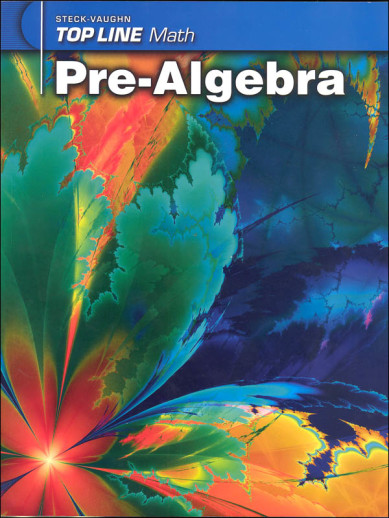We use cookies to make your experience better. To comply with the new e-Privacy directive, we need to ask for your consent to set the cookies. Learn more.
Top Line Math: Pre-Algebra
An inexpensive and well-organized way to provide targeted instruction in specific math skill sets. Start with a diagnostic test to determine exactly where students need work; then work through however many of these small but comprehensive worktexts are needed. Sounds simple, doesn't it - and it really is - with plenty of teacher support along the way. A great solution for helping a student catch up on specific skills or for general preparation of high school math or GED tests. An added bonus is the real-life application of the problems and instructions.
The Diagnostic Test is a five-page assessment resembling standardized tests. There are four problems relating to the content of each of the worktexts. A score of less than three correct answers for these indicates a need for further work in that area. The Diagnostic Teacher Guide provides instruction for administering the diagnostic, an answer/solution key, and a correlation sheet (so you'll know what problems pertain to what worktext). There is also a reproducible answer sheet for the diagnostic that the student can use to make scoring easier.
The Student Worktexts cover basic arithmetic skill sets as well as pre-algebra and general math skills. Each worktext has 3-5 units each with 4-6 lessons. Books start with a pre-test and end with a post-test (designed to build student confidence by seeing improvement). Lessons provide instruction, worked examples and a preliminary On Your Own problem; then practice laced with lots of real-world applications. Special sections highlight test-taking strategies (helpful since test prep seems a sub-goal of this series). Units are introduced with real-life applications. An overview of lessons highlights what will be learned and how that relates to what the student already knows. A review of each unit keeps the learning fresh. A number of helpful references are provided at the back of each book - a Glossary and a Math Toolkit. The Math Toolkit for the Fractions book includes a list of equivalent fractions and decimals, benchmark fractions, rules for fractions, estimation, key operation words, and a multiplication chart showing 15 x 15.
The Teacher Guides (one for each worktext topic) are both inexpensive and truly useful (and I don't say that often). In addition to the expected answer/solutions key and learning objectives/tips, etc. there is guided instruction for each lesson that provides a script for talking the student through the learning process including the examples and On Your Own problems. There is one TG page for each two-page student lesson and student pages are referenced rather than provided as reduced copies. Instruction is written to the student in the Worktext but not repeated in the TG. The TG content builds on the Worktext instruction in a question/answer type of dialog. Additional notes in the TG include those for English Language Learners, different learning styles, and references to using the Math Toolkit. There are references in the TG to downloadable/printable worksheets available at the publisher website but I suspect some changes in their availability as I was unable to find them on the parent-company website. There are some reproducible reference worksheets in the back of the TG itself.
While this series has some similarities to the Key to series, there are some significant differences as well. There is more instruction to the student in this series but perhaps slightly less actual practice. There is also more general real-world application in this series as well as a greater test-taking preparation emphasis. Parents can use this series to reteach just one area or use it for general instruction or test preparation (GED or standardized). Student Worktexts are typically 70 pgs, pb and have an accent color. Teacher Guides are 45 pgs, pb and hole-punched. ~ Janice
| Product Format: | Paperback |
|---|---|
| Brand: | Steck-Vaughn |
| Grades: | 9-AD |
| ISBN: | 9781419003721 |
| Length in Inches: | 10.875 |
| Width in Inches: | 8.375 |
| Height in Inches: | 0.1875 |
| Weight in Pounds: | 0.45 |

